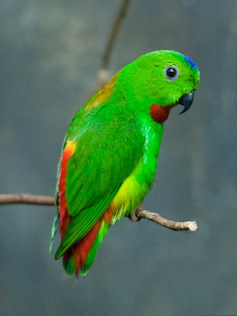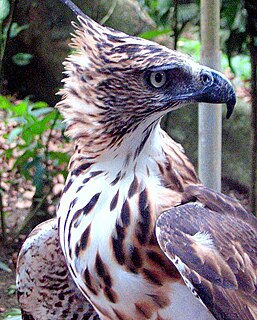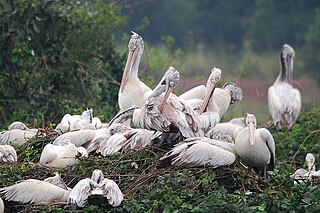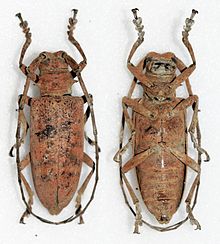
The blue rock thrush is a species of chat. This thrush-like Old World flycatcher was formerly placed in the family Turdidae. It breeds in southern Europe, northwest Africa, and from Central Asia to northern China and Malaysia. The blue rock thrush is the official national bird of Malta and was shown on the Lm 1 coins that were part of the country's former currency.

The spot-billed pelican or grey pelican is a member of the pelican family. It breeds in southern Asia from southern Iran across India east to Indonesia. It is a bird of large inland and coastal waters, especially large lakes. At a distance they are difficult to differentiate from other pelicans in the region although it is smaller but at close range the spots on the upper mandible, the lack of bright colours and the greyer plumage are distinctive. In some areas these birds nest in large colonies close to human habitations.

The hanging parrots are birds in the parrots genus Loriculus. This is a group of small parrots from tropical southern Asia.

The Philippine eagle-owl is a vulnerable species of owl belonging to the family Strigidae. It is endemic to the Philippines, where it is found in lowland forests on the islands of Catanduanes, Samar, Bohol, Mindanao, Luzon, Leyte and possibly Sibuyan. The Philippine eagle-owl feeds on rodents and amphibians. Due to their reliance on living in large lowland forests, forest conservation is important in order to maintain populations of the Philippine eagle-owl, which is becoming increasingly vulnerable to going extinct. The Philippine eagle-owl was previously listed as endangered, but due to destruction of lowland habitat and possible hunting, the eagle-owl has since been adjusted to the vulnerability of extinction.

The buff-banded rail is a distinctively coloured, highly dispersive, medium-sized rail of the rail family, Rallidae. This species comprises several subspecies found throughout much of Australasia and the south-west Pacific region, including the Philippines, New Guinea, Australia, New Zealand, and numerous smaller islands, covering a range of latitudes from the tropics to the Subantarctic.

The Philippine warty pig is one of four known species in the pig genus (Sus) endemic to the Philippines. The other three endemic species are the Visayan warty pig, Mindoro warty pig and the Palawan bearded pig, also being rare members of the family Suidae. Philippine warty pigs have two pairs of warts, with a tuft of hair extending outwards from the warts closest to the jaw. It has multiple native common names, but it is most widely known as baboy damo in Tagalog.

The Philippine hawk-eagle or north Philippine hawk-eagle, earlier treated under Spizaetus, is a species of bird of prey in the family Accipitridae. Many taxonomists consider the Pinsker's hawk-eagle, a former subspecies, raised to full species status. It is endemic to the Philippines. Its natural habitat is tropical moist lowland forests. It is threatened by habitat loss and trapping.

The Philippine hanging parrot is also widely known as the colasisi taken from its local Tagalog name, "kulasisi". It is a small parrot species of the family Psittaculidae. It includes about eleven subspecies, which are all native to only the Philippines; however, the exact taxonomy is unclear, and at least one of the subspecies might become split off and become a separate species if further research provides clarification. While it is listed as Least Concern in IUCN, some sub-species may already be possibly extinct such as the chyrsonotus sub-species in Cebu and the siquijorensis sub-species in Siquijor. Threats include habitat loss but its biggest threat is trapping as pets for the illegal wildlife trade where they are often sold in streets and online selling groups.
The Philippine hawk-owl is a species complex of owls in the family Strigidae. They are all endemic to the Philippines.

The Indian giant flying squirrel, also called the large brown flying squirrel or the common giant flying squirrel, is a species of rodent in the family Sciuridae. It is capable of gliding flight using a skin membrane stretched between front and hind legs. It is found in mainland Southeast and South Asia, and southern and central China.
The Macquarie rail, also known as the Macquarie Island rail, is an extinct subspecies of the buff-banded rail endemic to Macquarie Island, a subantarctic island that is part of the state of Tasmania, Australia. The holotype is in the collection of the Museum of New Zealand Te Papa Tongarewa.

Mount Malindang is a complex volcano located in the province of Misamis Occidental in the southern island of Mindanao, Philippines. It is the highest point in the province. The least studied mountain range was formed through several volcanic activities some of which could be historical, evident by the presence of two calderas, surrounded by high rock walls, cinder cones, dome volcano plugs, two sulfurous hot springs, and a crater lake named Lake Duminagat. The amphitheater structures have extensive distribution of volcanic rocks, carbonized wood that are found in pyroclastic deposits. The mountain range is dissected by several canyons and ravines.
Rafflesia philippensis is a parasitic plant species of the Rafflesiaceae family that was named by Francisco Manuel Blanco in his Flora de Filipinas in 1845. The species is known only from a mountain located between the provinces of Laguna and Quezon, Luzon where it was first discovered. Its plant host is Tetrastigma pisicarpum. This species went unnoticed since its first description by Blanco but was rediscovered in 2003 by members of the Tanggol Kalikasan, a local environment conservation group in Quezon province who first saw and photographed the open flower of this species. It was brought to the attention of Manuel S. Enverga University (MSEUF), who formed a team composed of students and faculty to document the newly discovered Rafflesia species.

Mallotus philippensis is a plant in the spurge family. It is known as the kamala tree or red kamala or kumkum tree, due to the fruit covering, which produces a red dye. However, it must be distinguished from kamala meaning "lotus" in many Indian languages, an unrelated plant, flower, and sometimes metonymic spiritual or artistic concept. Mallotus philippensis has many other local names. This kamala often appears in rainforest margins. Or in disturbed areas free from fire, in moderate to high rainfall areas.

Agapornithinae is a subfamily of psittacine birds, one of the five subfamilies that make up the family Psittaculidae. Its members are small, short-tailed parrots that inhabit Africa and Asia. They usually have predominantly green plumage and present different colorations on the head.

The Luzon hawk-owl or Luzon boobook is a species of owl in the family Strigidae. It is endemic to the Philippines where it lives in forests. It is a brown and white mottled bird and males and females look much alike.

Nelapattu Bird Sanctuary is a bird sanctuary in Nellore district, Andhra Pradesh, India, near the village of Nelapattu. It has an area of 458.92 hectares. It is an important breeding site for spot-billed pelicans.
Thestus alexandra is a species of beetle in the family Cerambycidae. It was described by James Thomson in 1878. It is known from Sumatra and Malaysia.
Thestus chassoti is a species of beetle in the family Cerambycidae. It was described by Stephan von Breuning in 1973. It is known from Malaysia.
Thestus oncideroides is a species of beetle in the family Cerambycidae. It was described by Francis Polkinghorne Pascoe in 1866. It is known from Sumatra and Malaysia.














